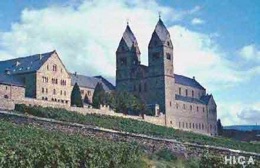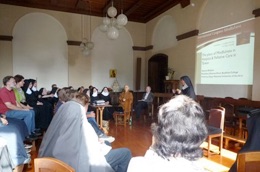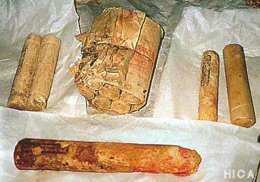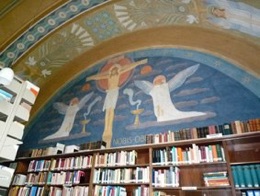HICA







Meeting again after 15 years at the Abbey of St Hildegard, Rüdesheim
on August 27th, 2011
Additional Note
St. Hildegard von Bingen lived in the 10th century in the upper Rhine valley in Germany. She was very gifted in mysticism and music. Her mercy and holiness convinced her fellowmen that she must be a saint. In the 12th century a convent was founded in her honour.
Today this abbey sets up the only workshop for the restoration of clerical archive material in Germany. This workshop was founded in 1974 because of the need to preserve ecclesiastical pieces of art.
About 15 years ago the restoration workshop of the Benedictine Abbey of St Hildegard near Bingen paid me a visit. Sister Dorothea and two of her fellow Sisters were staying at my workshop in Mannheim for two weeks. It was a happy time of hard and intense learning. When we had to take leave, we were all very sad. We have kept sending postcards for Christmas, but we have never met since then.
This summer finally, the Buddhist abbot Huimin Bhiksu came to see us in Mannheim, after having participated at a congress about mindfulness in Hamburg together with the Dalai Lama.
Well, I thought this would be a good opportunity to visit St Hildegard in Bingen again and to present Huimin Bhiksu an insight into the life in a European Christian monastery. A good idea, Sister Dorothea said when I called her with this proposal: The Dalai Lama had also been here many years ago.
So, by the end of August, after Mother Clementia had also given her consent to the visit, we drove to St Hildegard together with our Chinese abbot. We experienced a happy reunion and had a magnificent tour through the monastery and through the restoration workshop. Since our last visit, the workshop had been enlarged three times of its original size. We were very impressed by the up-to-date and valuable equipment as well as by the increasing activity of the workshop. This is certainly due to Sister Dorothea‘s commitment. She uses every opportunity of further education and development. Just at the time of our visit in Bingen, a historical Korean wall screen with a Chinese world map was waiting to be restored. Since Master Huimin is also a master of the electronic media, he was able to find promptly via his iPad, which interestingly was working well in the deep vaults of the Abbey, online information concerning the origin, provenance and dissemination of this kind of world map. And this in all of the world’s languages. Wow! We were mightily impressed!
Afterwards we had a Christian-Buddhist afternoon coffee break together with Mother Clementia and Sister Dorothea, whereat I enjoyed the delicious homemade cake. After that Master Huimin gave a speech.
It has been a jovial reunion and I would like to express my heartfelt thanks to the Abbey of St Hildegard!
Plans for a Restoration Centre for Buddhist Art in Asia
After visiting the restoration workshop of the Abbey of St Hildegard in 1996, I had the idea that my own country of origin would also benefit from such an institution. Until now there has been no comparable insitute, where religious artworks can be restored, in Taiwan and China. But, in my opinion, it is very much needed because many artworks had been damaged during major waves of religious persecution, during the Tai-ping rebellion and the Cultural Revolution.
There are plans for a special institute, a centre devoted to preserve Buddhist paintings and scrolls. Furthermore, it would restore holy scriptures, books and albums of various forms and materials. It would work for private as well as for public art collections in Taiwan, China and other Buddhist countries. A well-educated team of restorers would apply advanced as well as classical Eastern and Western restoration techniques. The workshop would have to be equipped according to international standards.
1996

Tagebuch
Diary
Workshop for the restoration of clerical archive material
for the residents of the Abbey of St. Hildegard in Rüdesheim
March 1996, Mannheim
In the restoration workshop of Ms Hai-Yen Hua-Ströfer in Mannheim an intensive course about lining methods used in restoration took place at the beginning of March 1996. A special emphasis was laid on the preparation and processing of a strongly adhesive paste made of wheat starch. Furthermore, adhesion problems on various materials were dealt with. An important conclusion during this advanced training was: It depends on the paste itself and on the method used to coat the material with it.
Ms Hua-Ströfer conveyed very skillfully and with great commitment the various lining methods and also the stretching on the drying wall. The days were characterized by an atmosphere of extraordinary hospitality.
In the name of the Sisters of the restoration workshop in the Abbey St Hildegard, Eibingen near Rüdesheim, I thank you for the intensive course,
Sr Dorothea Flandera OSB 1996


